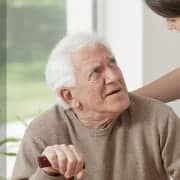Osteoporosis Protection in an Assisted Living Facility
Because May is National Osteoporosis Awareness and Prevention Month, Assisted Living Education is sharing some of our insights and suggestions in helping prevent and protect our elderly residents against dangers related to osteoporosis. In an assisted living facility, it is crucial to take a proactive approach in safeguarding our residents.
The International Osteoporosis Foundation estimates that in the age group over 50, 1 in 2 women and 1 in 4 men are at risk for an osteoporotic fracture. Many people are unaware they have osteoporosis, a decrease in bone density, and are in fact diagnosed after they incur a fracture.
Who is at risk and how can we help?
Post-menopausal women over 65, and men over 70 are at higher risk of developing osteoporosis. Risk factors for osteoporosis can include a genetic predisposition; lifestyle factors including lack of exercise or smoking, which expedites bone loss; and diet deficiencies, including lack of calcium or lack of Vitamin D. While a lifetime of good or bad habits has already impacted an individual, there are some things we can do at our assisted living facilities to encourage some changes and either help maintain good habits or support better ones.
Of course, all activities and changes must be approved by the resident’s attending doctor or physical therapists.
Exercise
It’s common to think that a person’s inability or struggle to walk long distances, carry or lift certain items, or even climb stairs is due to the onset of old age. In fact, it’s actually the lack of sustained exercise in a person’s life that contribute to these difficulties in older age.
Though by the time we receive our elderly residents, we can’t change what the past has written into their bodies, we can still make an effort to maintain their strength and some flexibility. This can help to prevent any future injuries.
Even if residents aren’t fully ambulatory, stretching and incorporating extra movement in their day can have a positive effect on both physical and mental health. Movement can keep the joints warm, and also prevent muscle and bone atrophy.
For residents who are capable, weight-bearing exercises (also called “resistance exercise” or “strength training”) are excellent in building bone density and maintaining healthy bones. Walking, Tai Chi, yoga, dancing, and weightlifting are all great examples, and can even help improve balance and stability as well. Modified versions of these activities are beneficial as well. The International Osteoporosis Foundation states that there is a 47% decrease in the amount of falls by people who practice Tai Chi than those who don’t, and a 25% decrease in the rate of hip fractures.
Diet
The food service department, as well as the in-house registered dietitian should ensure that residents are receiving a diet that supports bone and overall health, as well as remaining within any personal diet restrictions. Additionally, the dietitian can recommend vitamin or other dietary supplements that may benefit the resident as well.
Clear Pathways & Easy Access
Hallways and common areas of the facility should always maintain clear pathways, but it is also important to ensure that a resident’s room or personal space is kept neat and clear as well. Nurses, CNAs, or other caregivers can take a quick glance-over when possible to check on their spaces. Also, make sure walking aids, such as canes or walkers, are within close reach of the bed, even if the resident requires assistance to get in/out of bed or stand/sit down.
Make sure the resident’s most commonly used items are easily accessible (toiletries, books, etc.) to prevent unnecessary bending or stooping which may result in a misstep or injury. Physical or occupational therapists may even suggest having a long-arm reaching tool/grabber handy in case a resident drops something and attempts to pick it up.
Falling or tripping is a major fear and risk for an individual with osteoporosis, and the elderly population in general. For an extensive and thorough list of preventative actions a healthcare facility can implement, our blog Preventing Falls for Elderly Residents discusses in detail how to keep residents safe from falls and injuries.
Medications
Many of the medications used to treat osteoporosis are biphosphonates, which help slow the breakdown process of the bones. Our bones go through a normal breakdown and rebuilding cycle, but as we age, the rebuilding process cannot always keep up with the breakdown. Biphosphonates slow the cells that break bones down (osteoclasts), allowing the building cells (osteoblasts) to work more effectively, and overall help maintain bone density. There are other kinds of medications that also help reduce the risk of fractures, and even one which may even reverse the effects of osteoporosis, but those are reserved for more severe cases. Of course, the resident’s doctor or attending doctor will review each case and decide whether osteoporosis medications are appropriate for the individual.
During the admissions process and subsequent exams, residents will undergo thorough medical evaluations to examine their physical, mental & cognitive abilities, as well as a fall risk assessment to determine if extra precautions are necessary.
_____________
Assisted Living Education is a premier provider in assisted living services, and is dedicated to providing relevant news and updates regarding elderly care. Additionally, we offer RCFE Administrator Certification Training, other assisted living facility staff training, and continuing education courses. We are proud of our teachers, who are industry professionals ready to share their years of experience with highly engaging and informative delivery. For more information, visit our contact page to reach us for any questions.






